Introduction: More Than Just Greenery – The Soul of Your Space
Imagine walking into a room that feels instantly alive. Sunlight filters through the leaves of a lush, green plant, casting soft, dappled shadows on the wall. The air feels fresher, the space feels calmer, and every corner whispers a welcome. This isn’t just a fantasy; it’s the transformative power of house plants decor.
Gone are the days when a lone, dusty succulent on a windowsill was enough. Today, integrating greenery into our homes is a fundamental part of creating a sanctuary. It’s a design movement that bridges the gap between the built environment and the natural world we crave. Whether you’re a seasoned plant parent with a thriving jungle or a nervous newbie wondering if you can keep a cactus alive, this guide is for you.
We’re diving deep into the art and science of using plants for home decor with plants. We’ll explore how to style every room, from sprawling living rooms to cozy studio apartments. We’ll uncover the secrets of choosing the right plants, arranging them for maximum impact, and avoiding common pitfalls. Get ready to discover how the perfect house plants decor can turn your house into a Cozy Nest. (See our guide on [maximizing natural light in your home] for more tips that complement your green decor)House Plants Decor.
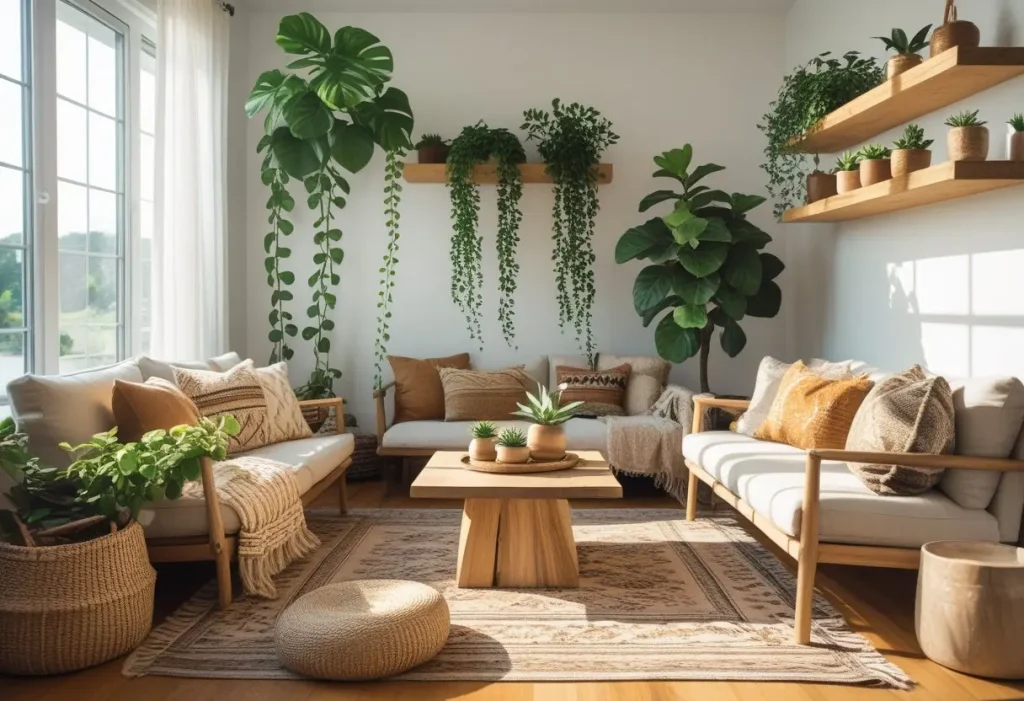
Table of Contents
- Introduction: More Than Just Greenery – The Soul of Your Space
- The Unbeatable Benefits of House Plants Decor
- Your Room-by-Room Guide to House Plants Decor
- Small Space, Big Impact: House Plants Decor for Apartments
- The Ultimate Styling Guide: Principles of Home Decor with Plants
- The Great Debate: Fake vs. Real Plants in Home Decor
- Top 10 Trending House Plants for Modern Home Decor in 2025
- Common House Plants Decor Mistakes (And How to Avoid Them)
- The 2025 Forecast: Top Trends in Indoor Plants Decoration Ideas
- Conclusion: Your Cozy Nest Awaits
- Frequently Asked Questions (FAQs) About House Plants Decor
The Unbeatable Benefits of House Plants Decor
Why has house plants decor become such a phenomenon? It’s not just about aesthetics. The reasons are rooted in our very biology and psychology House Plants Decor.
Breathe Easier: The Health and Wellness Perks
The NASA Clean Air Study is often cited, and for good reason. It revealed that many common house plants are powerful natural air purifiers. They absorb harmful toxins like formaldehyde, benzene, and trichloroethylene, common in furniture, carpets, and cleaning products. Furthermore, plants release moisture into the air through transpiration, acting as a natural humidifier. This can alleviate dry skin, sore throats, and even reduce the survival of airborne viruses. Incorporating house plants decor is a simple, beautiful step towards a healthier home environment.
From House to Home: The Psychological Magic
The benefits go far beyond physical health. Studies consistently show that being around plants reduces stress, lowers blood pressure, and decreases feelings of anxiety. In our fast-paced, screen-dominated lives, a touch of green provides a crucial mental reset. Caring for plants offers a sense of purpose and a rewarding connection to a living thing. In workspaces, indoor plants decoration ideas have been linked to increased concentration, productivity, and creativity by up to 15%. They literally help us think better House Plants Decor.
Style That Speaks: The Aesthetic Advantage
Aesthetically, plants are the most versatile decor element you can own. They add color, texture, and life in a way that no piece of art or furniture can. They can soften harsh architectural lines, fill empty corners, and become the focal point of any room. Whether your style is minimalist, bohemian, modern, or rustic, there’s a plant and a styling method that will enhance it. House plants decor is the ultimate tool for personalizing your space and making it uniquely yours House Plants Decor.
Your Room-by-Room Guide to House Plants Decor
Every room in your home has a different purpose, microclimate, and lighting condition. Let’s break down the best indoor plants decoration ideas for each space House Plants Decor.
The Living Room: Your Green Statement Piece
The living room is the heart of the home—a place for relaxing, entertaining, and gathering. It’s also the perfect canvas for bold house plants decor House Plants Decor.
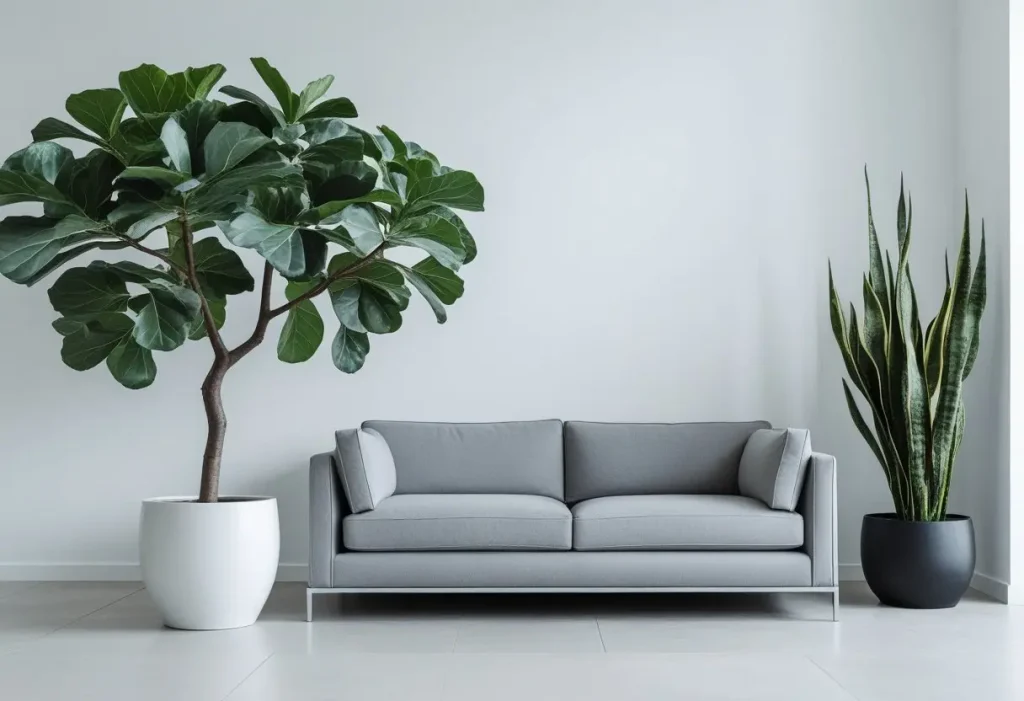
- Statement Makers: Go big and bold. A Fiddle Leaf Fig is a classic for a reason—its large, glossy leaves command attention. A Rubber Plant (Ficus elastica) with its dark, dramatic leaves, or a Monstera Deliciosa with its iconic split leaves, are also fantastic choices for a living room plant styling centerpiece.
- Height and Structure: Use tall, structural plants to define spaces. A Snake Plant (Sansevieria) or a ZZ Plant (Zamioculcas zamiifolia) in a corner can frame a seating area beautifully. They are nearly indestructible and thrive on neglect.
- Shelf and Mantel Decor: For shelves, consoles, and mantels, think trailing and textural. A String of Pearls, a lush Pothos, or a Philodendron Brasil add movement and soften edges. Cluster a few small pots together, like a Pilea Peperomioides (Chinese Money Plant) with a Fittonia (Nerve Plant) for a curated look.
- Coffee Table Centerpieces: A small, elegant plant can be a living sculpture on your coffee table. An Air Plant (Tillandsia) in a geometric holder, a Zebra Haworthia, or a small Orchid add a touch of sophistication without taking up too much space.
The Bedroom: A Serene Sanctuary for Sleep
The bedroom should be a haven for rest and rejuvenation. Your house plants decor here should promote calm and improve sleep quality, creating a peaceful environment for better relaxation.
- Air-Purifying Champions: Certain plants are superstars at filtering air and releasing oxygen at night. The Snake Plant and Areca Palm are top performers. The Snake Plant is particularly effective in the bedroom.
- Calming Aromas and Textures: A Lavender plant on a sunny windowsill can release its soothing scent. A Boston Fern adds a soft, feathery texture that feels incredibly calming. English Ivy is another great trailing option that can help purify the air.
- Placement is Key: Avoid cluttering surfaces. A tall plant in a corner, a hanging plant near a window, or a single, beautiful specimen on your nightstand is all you need. The goal is to create a sense of peace, not a jungle. For more bedroom indoor plants inspiration, consider plants with rounded, soft leaves, which are psychologically more soothing than spiky ones.
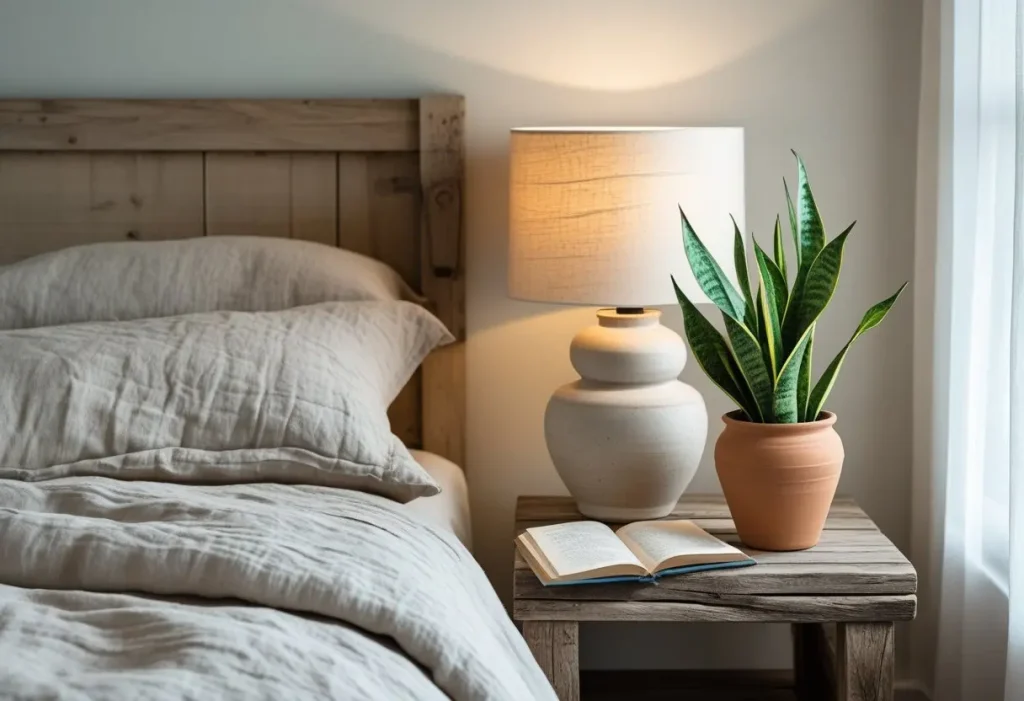
The Bathroom: A Tropical Oasis Awaits
The bathroom is often the most overlooked space for plants, but its high humidity and (often) low light make it an ideal environment for many tropical species.
- Humidity Lovers: Orchids thrive in steamy bathroom conditions. Ferns, like the Boston Fern or Maidenhair Fern, will revel in the moisture. Spider Plants and Peace Lilies are also excellent, adaptable choices.
- Low-Light Thrivers: If your bathroom has no window, don’t despair. A ZZ Plant or Snake Plant can handle very low light. A Pothos will also adapt and continue to grow, albeit more slowly.
- Styling Ideas: Place plants on vanity counters, the edge of the bathtub, or in hanging planters from the ceiling or shower rod. A shelf above the toilet is another perfect spot for a small collection of humidity-loving house plants decor.
The Home Office: Boost Productivity & Creativity
Transform your workspace from sterile to stimulating with thoughtful house plants decor.
- Focus and Fatigue Reduction: Studies show that having plants in your line of sight can reduce mental fatigue and increase attention. A Snake Plant or ZZ Plant on your desk is low-maintenance and effective.
- Desktop Delights: Small plants are perfect for desks. A Succulent collection, a Chinese Money Plant, or a Jade Plant are great choices. Their care can provide a mindful break during a busy workday.
- Shelf and Floor Companions: If you have floor space, a Monstera or Rubber Plant can make the whole room feel more inviting. On shelves, use trailing plants like Philodendron or Pothos to add life without taking up valuable work surface.
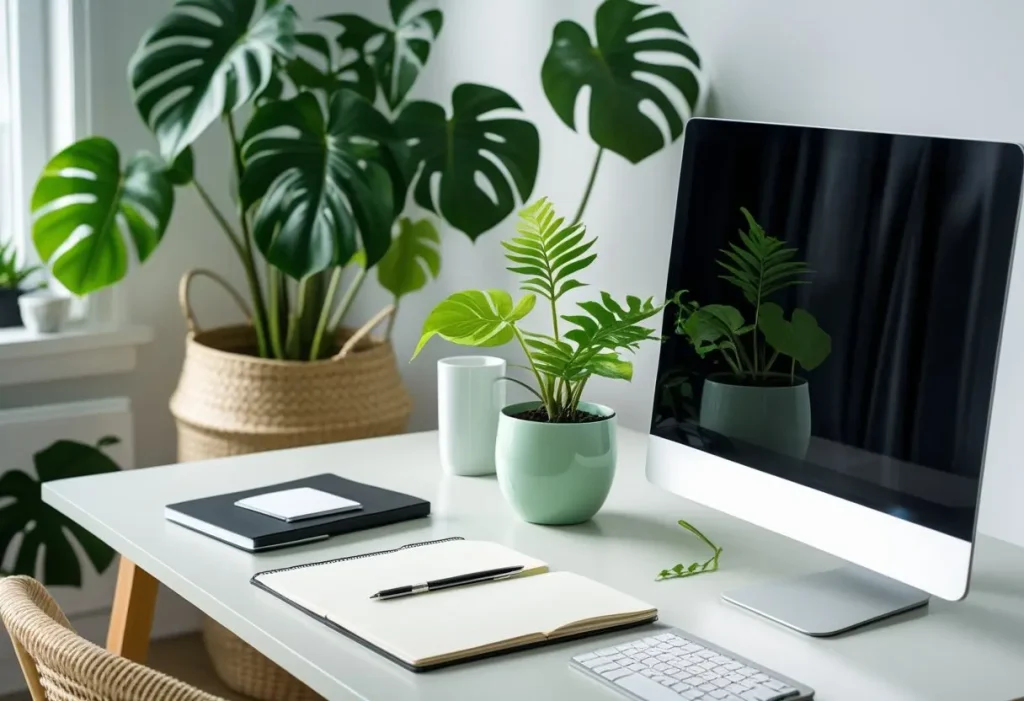
The Kitchen: Fresh Herbs and Vibrant Life
The kitchen is a space of utility and warmth. House plants decor here can be both beautiful and functional.
- The Herb Garden: There’s nothing more satisfying than cooking with herbs you’ve grown yourself. A sunny windowsill is the perfect spot for a pot of Rosemary, Basil, Mint, Thyme, and Parsley. Not only do they smell amazing, but they provide fresh flavor at your fingertips.
- Sun-Loving Companions: If you have a bright kitchen, a String of Pearls hanging in the window, an Aloe Vera plant on the counter (handy for burns!), or a Croton with its vibrant, colorful leaves can add a huge dose of personality.
- Styling on Open Shelving: If you have open shelves, intersperse your dishes and glasses with small potted plants. A Spider Plant or a Succulent arrangement can break up the monotony and add a fresh, lively touch.
The Balcony & Patio: Your Personal Urban Jungle
Extend your house plants decor to the outdoors to create a seamless flow between inside and out.
- Creating Layers: Use a mix of floor-standing pots, hanging baskets, and wall planters to create a lush, multi-dimensional feel. This is the perfect place to experiment with colorful flowering plants alongside foliage favorites.
- Privacy Screens: Use tall plants like Bamboo, Clumping Grasses, or a tall Ficus to create a natural privacy screen from neighbors.
- Vertical Gardens: If floor space is limited, a vertical pallet garden or a set of wall-mounted planters can hold a stunning array of herbs, succulents, and trailing plants, maximizing your small space plant decor potential.
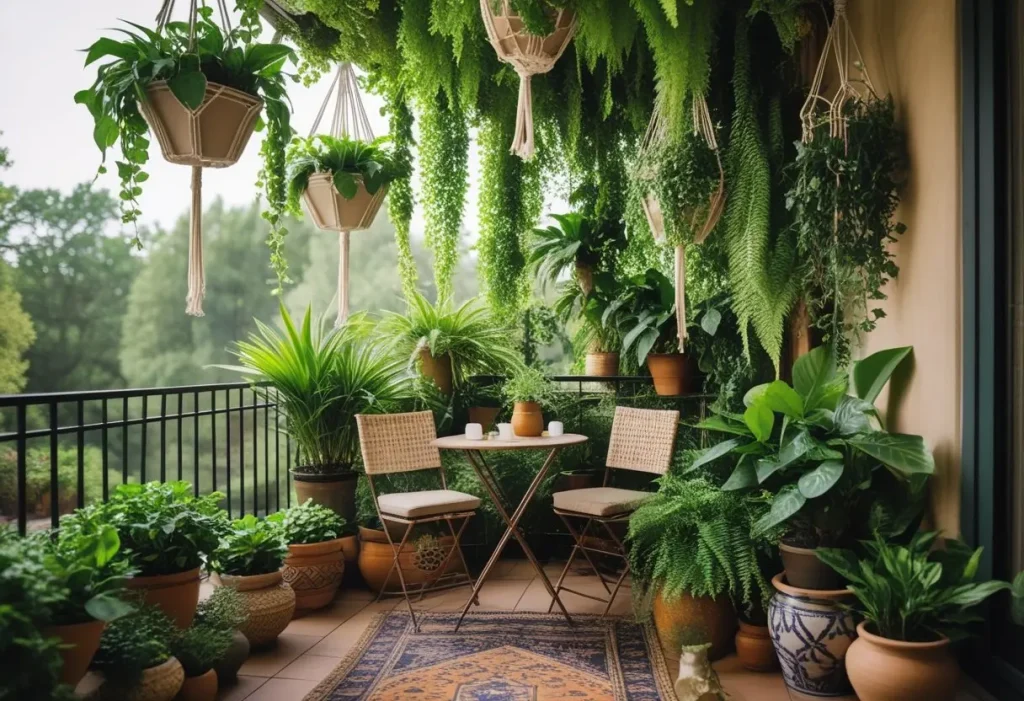
Small Space, Big Impact: House Plants Decor for Apartments
Living in a small apartment doesn’t mean you have to miss out on the joy of house plants decor. It simply requires a smarter, more vertical approach.
Thinking Vertical: Wall-Mounted and Hanging Gardens
Floor space is a premium in small homes, so look up!
- Hanging Planters: Macrame hangers are a beautiful way to display trailing plants like Pothos, Philodendron, String of Hearts, or Spider Plants. They draw the eye upward, making the room feel taller.
- Wall-Mounted Shelves and Pots: Install floating shelves specifically for your plant collection. A “living wall” with a series of small, identical pots can become a stunning piece of living art. This is one of the most popular indoor plants decoration ideas for urban dwellers.
- Pegboards: An Ikea SKADIS pegboard or similar system is incredibly versatile. You can add small shelves and hooks to hold a collection of tiny succulents, air plants, and herbs, creating a customizable and functional house plants decor display.
Tiny but Mighty: The Best Plants for Compact Areas
Choose plants that have a small footprint but a big personality.
- Air Plants (Tillandsia): These soil-less wonders can be placed in shells, on driftwood, or in special glass orbs. They are the ultimate space-savers.
- Succulents: Echeverias, Haworthias, and Jade Plants are small, sculptural, and slow-growing, perfect for windowsills and desks.
- Small-Stature Favorites: The Chinese Money Plant (Pilea), Nerve Plant (Fittonia), and Peperomia species all stay relatively small and are perfect for adding pops of green to shelves and countertops without overwhelming them.
The Ultimate Styling Guide: Principles of Home Decor with Plants
Anyone can put a plant in a corner, but styling them artfully is what elevates your house plants decor from amateur to expert.
The Rule of Three: Creating Visual Harmony
In design, odd numbers, particularly groups of three, are more visually appealing and memorable than even numbers. Instead of placing two identical plants side-by-side, create a trio. This could be three plants of the same type in pots of varying heights, or three different plants that share a common color or texture, grouped together to form a single, cohesive statement.
Playing with Height and Scale
A common mistake is having all plants at the same height. This creates a flat, uninteresting look. Create a dynamic composition by using:
- A Thriller: One tall, dramatic plant (e.g., a Fiddle Leaf Fig or Bird of Paradise).
- A Filler: A medium-height, bushy plant to add volume (e.g., a Philodendron or Fern).
- A Spiller: A trailing plant that spills over the edge of its pot (e.g., a Pothos or String of Pearls).
Apply this principle to a single large pot (a container garden) or to a group of pots arranged together in a corner.
The Art of the Pot: Choosing Your Vessels
The pot is the “outfit” for your plant, and it can make or break the look.
- Material Matters: Terracotta is classic, breathable, and great for succulents. Ceramic glazed pots come in endless colors and finishes for a polished look. Concrete offers a modern, industrial vibe. Woven baskets add a natural, bohemian texture.
- Color and Pattern: Choose pots that complement your room’s color palette. A neutral pot lets the plant be the star. A boldly colored pot can be a statement piece in itself house plants decor.
- Cohesion with Variety: It’s often effective to use the same color or material of pot throughout a room to create cohesion, even if the pot shapes and sizes vary house plants decor.
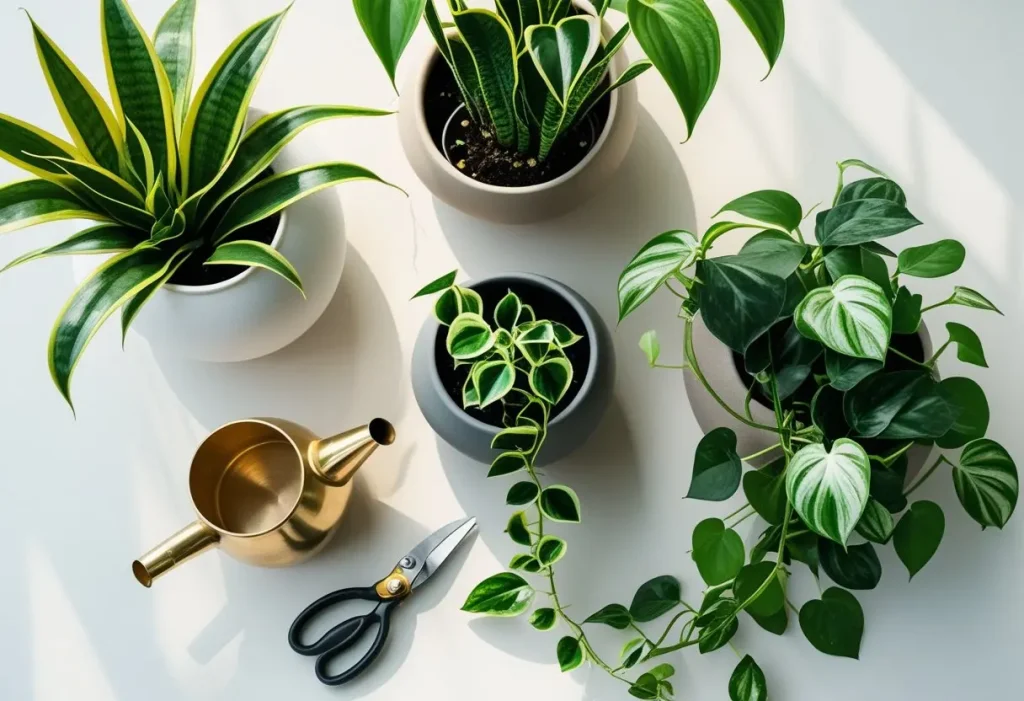
Texture and Color: Building a Lush Tapestry
Don’t just think green; think texture. Combine plants with large, glossy leaves (Rubber Plant) with those that have feathery, delicate fronds (Asparagus Fern), or spiky, architectural shapes (Snake Plant). This variation in texture creates a rich, layered look that is far more interesting than a collection of similar-looking plants. For color, consider plants with variegated leaves (like the Tricolor Stromanthe or Calathea Whitestar), or deep, almost-black leaves (like the Zamioculcas ‘Raven’) house plants decor.
The Great Debate: Fake vs. Real Plants in Home Decor
This is a common dilemma in the world of home decor with plants. Let’s weigh the pros and cons objectively.
The Case for Artificial Plants
- Pros:
- Zero Maintenance: No watering, pruning, or worrying about light.
- Consistency: They always look the same, which can be desirable in certain commercial or design settings.
- Allergy-Friendly: A solution for those with plant-related allergies.
- Viable for Impossible Conditions: Can be used in pitch-black corridors or rooms with no natural light.
- Cons:
- No Health Benefits: They do not purify the air or increase humidity.
- No Psychological Boost: The proven stress-reducing effects are absent.
- Dust Magnets: They require regular dusting to look their best.
- Can Look Cheap: Low-quality fake plants can detract from your decor. High-quality, realistic ones can be very expensive.
The Irreplaceable Charm of Living Plants
- Pros:
- All the Benefits: You get the full package: air purification, humidity, and mental well-being.
- A Living Element: They grow and change, creating a dynamic, evolving space. The sense of accomplishment from caring for them is real.
- Authenticity: There is a depth and vitality to a living plant that even the best fake cannot perfectly replicate.
- Cons:
- Maintenance Required: They need water, light, and occasional care.
- Can Attract Pests: Fungus gnats and other pests can be an occasional issue.
- Can Die: Improper care can lead to a sad, wilted, or dead plant.
Our Verdict and Hybrid Solutions
For a home environment, we firmly believe that living plants are always the superior choice for house plants decor due to their holistic benefits. However, a hybrid approach is perfectly valid. Use real plants wherever possible, and reserve high-quality artificial plants for those spots where a real one would simply not survive (e.g., a dark corner in a hallway where you still want a touch of green). The key is to be intentional and choose the best quality artificial plants you can afford.
Top 10 Trending House Plants for Modern Home Decor in 2025
The plant world has its trends, too! Here are the varieties that are defining modern home decor with greenery for 2025.
- Monstera Thai Constellation: The highly variegated, starry-night version of the classic Monstera. It’s the ultimate “it” plant for a reason.
- Philodendron Pink Princess: With stunning splashes of hot pink on dark green leaves, this plant adds a dramatic pop of color.
- ZZ Plant ‘Raven’: Its new growth comes in lime green, dramatically maturing to a deep, glossy black. Incredibly striking and low-maintenance.
- String of Hearts: A delicate, fast-growing trailer with heart-shaped, variegated leaves. Perfect for high shelves and hanging planters.
- Ficus Tineke (Rubber Plant): The variegated cousin of the classic Rubber Plant, with stunning cream, pink, and green leaves. A stunning, architectural statement.
- Calathea Orbifolia: Known for its huge, almost perfectly round leaves with silvery stripes. It adds a bold, graphic element.
- Hoya Kerrii (Sweetheart Hoya): Often sold as a single, heart-shaped leaf in a pot, it’s a symbol of love. A mature, vining one is a true treasure.
- Alocasia ‘Polly’ (African Mask Plant): With its dark, arrow-shaped leaves and stark white veins, it has a dramatic, almost graphic-novel aesthetic.
- Pilea Peperomioides (Chinese Money Plant): Its unique, pancake-shaped leaves on upright stems continue to captivate plant lovers.
- Staghorn Fern: Mounted on a board and hung on the wall, this epiphyte is a living piece of art and a prime example of creative indoor plants decoration ideas.
Common House Plants Decor Mistakes (And How to Avoid Them)
Even with the best intentions, it’s easy to make mistakes. Here’s how to sidestep the most common ones.
- Ignoring Light Needs: The #1 killer of houseplants. Don’t put a sun-loving succulent in a dark bathroom or a shade-loving fern in a south-facing window. Always check the plant’s light requirements before you buy.
- Overwatering: More plants die from overwatering than underwatering. Stick your finger in the soil. If the top 1-2 inches are dry, it’s time to water. When in doubt, wait it out.
- Choosing Style Over Substance: Don’t choose a plant purely for its looks if you can’t provide its needs. Be realistic about your home’s conditions and your own habits.
- Forgetting to Dust: Dust on leaves blocks sunlight and hinders photosynthesis. Wipe large leaves with a damp cloth and gently rinse smaller-leaved plants in the shower occasionally.
- Skipping the Drainage Hole: A pot without a drainage hole is a swimming pool for roots. Always ensure excess water can escape, either through a hole in the pot or by using a nursery pot inside a decorative cachepot.
- Island Syndrome: Placing a single, small plant in the middle of a large, empty room or table. Plants look best when they feel connected to other elements. Place them in corners, on shelves with other objects, or group them together.
The 2025 Forecast: Top Trends in Indoor Plants Decoration Ideas
Looking ahead, the world of house plants decor is becoming even more innovative and personalized.
- Biophilic Design Goes Mainstream: This design philosophy, which seeks to connect occupants more closely with nature, is moving beyond offices and into homes. Expect to see built-in planters, green walls, and large, architectural plants as integral parts of interior architecture.
- Smart Plant Tech: Self-watering pots, app-connected sensors that monitor soil moisture and light, and sophisticated grow lights are making plant care more accessible than ever.
- Gothic Gardens: A move towards darker, more dramatic foliage. Plants with black, deep purple, and burgundy leaves (like the Raven ZZ, Black Magic Taro, and Oxalis Triangularis) are rising in popularity.
- Sustainable and Local: There’s a growing awareness around sustainably sourced plants and pots made from recycled or eco-friendly materials. Supporting local nurseries is also a key trend.
- The “Cluttered Curated” Look: Moving away from sparse minimalism, the trend is towards abundant, layered collections. Think shelves overflowing with a mix of plants, books, and art, creating a deeply personal and cozy “nest.” This is the heart of the CozyNestDecor philosophy.
Conclusion: Your Cozy Nest Awaits
The journey into house plants decor is one of the most rewarding you can take in home design. It’s a practice that beautifies your space while nurturing your well-being. It teaches patience, offers daily moments of mindfulness, and fills your home with living, breathing art.
Start small if you need to. Choose one resilient plant, find it the perfect spot, and select a pot that makes your heart sing. Watch how that single element of life transforms the energy of the room. From there, let your confidence grow. Experiment with different varieties, play with groupings, and don’t be afraid of a little trial and error.
Your home is your sanctuary. Let house plants decor be the key to unlocking its fullest, most vibrant, and coziest potential. We’re here to help you on every step of that journey. Explore our site for more guides, tips, and inspiration to build the home of your dreams. Now, go get your hands dirty!
Frequently Asked Questions (FAQs) About House Plants Decor
What are the best indoor plants for home decor for beginners?
For beginners, the best plants are forgiving and low-maintenance. Top picks include the Snake Plant (thrives on neglect), ZZ Plant (handles low light and irregular watering), Pothos (fast-growing and versatile), Spider Plant (produces cute “babies”), and Cast Iron Plant (as tough as its name suggests). These are perfect for dipping your toes into the world of house plants decor.
How do you style a small living room with plants?
Styling a small living room with plants is all about maximizing vertical space and avoiding clutter. Use hanging planters from the ceiling or wall-mounted shelves to keep floors clear. Choose a single, tall, statement plant for a corner (like a Snake Plant) instead of several small ones. Use trailing plants on shelves to draw the eye upward. Stick to a cohesive color scheme for your pots to create a streamlined look.
Which plants are best for bedrooms?
The best bedroom indoor plants are those that purify the air and promote relaxation. The Snake Plant is a top choice as it releases oxygen at night. The Areca Palm is a gentle humidifier and air purifier. Lavender offers calming aromatherapy, and English Ivy has been shown to help reduce airborne mold. Avoid plants with strong fragrances if you are sensitive to smells while sleeping.
What is the easiest indoor plant to care for?
This is a tie between the Snake Plant (Sansevieria) and the ZZ Plant (Zamioculcas zamiifolia). Both can survive weeks without water, tolerate a wide range of light conditions (from low to bright indirect), and are generally pest-resistant. They are the ultimate “set it and forget it” plants for home decor with plants.
How can I decorate my office with indoor plants?
Start with a low-maintenance plant on your desk, like a Succulent, Pilea, or ZZ Plant. If you have more space, add a floor plant like a Monstera or Peace Lily behind you for a great backdrop on video calls. Use a hanging plant near a window or a small, trailing plant on a bookshelf. The key is to choose plants that don’t require constant attention, so they don’t become a distraction.
Do house plants improve air quality?
Yes, significant research, including the famous NASA study, has shown that house plants can improve air quality. They absorb carbon dioxide and release oxygen through photosynthesis. More importantly, they can remove volatile organic compounds (VOCs) like formaldehyde, benzene, and xylene from the air through a process called phytoremediation. While you would need a large number of plants to fully purify the air in a home, they undoubtedly contribute to a healthier indoor environment.
What is the 2025 trend in indoor plant decoration?
The leading 2025 trend in indoor plant decoration is Biophilic Design, which integrates nature directly into the architecture and decor of a space. This includes dedicated plant nooks, living walls, and statement-making large-scale trees inside the home. We’re also seeing a rise in “Gothic Gardens” with dark-foliaged plants, and the use of smart technology to make plant care easier and more precise. The overall aesthetic is moving towards a curated, abundant, and personal “cluttered” look that feels cozy and lived-in.New chat